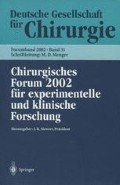Abstract
Background. Expression and activation of hepatocyte growth factor (HGF) is stimulated by a complex system of interacting proteins. Thrombin plays an initial role in this process activating the HGF activator. We investigated the impact of temporary occlusion of the hepatobiliary tract with fibrin glue (major component thrombin) on the HGF expression (in liver and kidney) in thioacetamide-induced liver damage in a rat model. Method. In 50 rats liver damage was induced by daily intraperitoneal (i.p.) application of thioacetamide (100 mg/kg) for 14 days. After 7 days laparotomy was performed in all animals. The common bile duct was microsurgically isolated and cannulated with a silicone tube. In the experimental group (n = 25) 0.2 ml fibrin glue was injected into the hepatobiliary tract (control group/n = 25: injection of 0.2 ml sodium chloride 0.9%) Daily i.p. administration of thioacetamide continued for 7 consecutive days. Then animals were sacrificed for blood analysis and immunohistochemical detection of HGFα, HGFβ, and the c-met-receptor. To investigate HGF expression Northern blotting was performed with hybridization of hepatic RNA with an analogous, rat-specifìc [α32P]cDNA-HGF probe. In conclusion, intrahepatic HGF-RNA content could be analysed by scanning membrane radioactivity. Results. Fibrin glue occluded animals showed significantly lower liver enzyme activities and serum levels of bilirubin, creatinine and urea nitrogen. Immunohistochemistry revealed a significant increase in HGFα- and especially HGFβ-positive cells (7-fold higher) in the liver. In the renal medulla HGFβ-positive cells were also significantly increased (4-fold higher). Intrahepatic HGF-RNA content was significantly higher in fibrin glue-treated animals (+35%). Conclusion: Application of thrombin (via fibrin glue occlusion of the hepatobiliary tract) is able to activate HGF expression in the liver. Due to this positive effect fibrin glue application might be useful in the future treatment of toxic liver damage.
Access this chapter
Tax calculation will be finalised at checkout
Purchases are for personal use only
Literatur
Ishiki Y, Ohnishi H, Muto Y, Matsumoto K, Nakamura T (1992) Direct evidence that hepatocyte growth factor is a heptotrophic factor for liver regeneration and for potent anti-hepatitis action in vivo. Hepatology 16: 1227–1235
Fujiwara K, Nagoshi S, Ohno A, Hirata K, Ohta J, Mochida S, Tomiya T, Higashio K, Kurokawa K (1993) Stimulation of liver growth by exogenous human hepatocyte growth factor in normal and partially hepatectomized rats. Hepatoloy 18: 1443– 1449
Masuhara M, Yasunaga M, Tanigawa K, Tamura F, Yamashita S, Sakaida I, Okita K (1996) Expression of hepatocyte growth factor, transforming growth factor alpha and transforming growth factor beta 1, messenger RNA in various human liver diseases and correlation with hepatocyte proliferation. Hepatology 24: 323 - 329
Shimomura T, Kondo J, Ochiai M, Naka D, Miyazawa K, Morimoto J, Kitamura N (1993) Activation of the zymogen of hepatocyte growth factor activator by thrombin. J Biol Chem 268: 22927 - 22932
Miyazawa K, Shimomura T, Kitamura N (1996) Activation of hepatocyte growth factor in the injured tissues is mediated by hepatocyte growth factor activator. J Biol Chem 271: 3615–3618
Author information
Authors and Affiliations
Rights and permissions
Copyright information
© 2002 Springer-Verlag Berlin Heidelberg
About this paper
Cite this paper
Schmandra, T.C., Stamer, N., Beck, K.F., Pfeilschifter, J., Hanisch, E. (2002). Induktion der HGF-Expression in Leber und Medulla renalis durch hepatische Fibrinkleberapplikation im toxischen Leberschaden. In: Chirurgisches Forum 2002. Deutsche Gesellschaft für Chirurgie, vol 31. Springer, Berlin, Heidelberg. https://doi.org/10.1007/978-3-642-56158-0_63
Download citation
DOI: https://doi.org/10.1007/978-3-642-56158-0_63
Publisher Name: Springer, Berlin, Heidelberg
Print ISBN: 978-3-540-43300-2
Online ISBN: 978-3-642-56158-0
eBook Packages: Springer Book Archive

